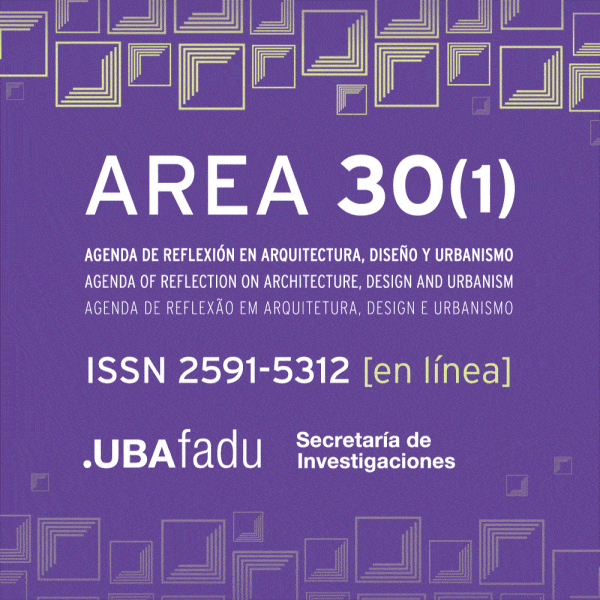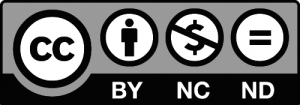
NOVEMBER 2023 / APRIL 2024
Director: Dra. Arq. Rita Laura Molinos
Editor: Dra. María Ledesma
Coeditor: DG. Miguel A. Santángelo
Technical editor: DG. Emiliano M. Eseiza
© The contents and metadata of this magazine are licensed under Open Access CC BY-NC-ND 2.5 AR
DNDA registration of the digital edition in process

Contents
Dossier “Activist Design”
Introduction
Dra. Raquel Pelta y Dra Mariana Salgado
Activism in architecture: towards a characterization of collectives in Latin America
Nicolás Ventroni
Abstract
The article proposes the construction of a generalist characterization of activist practices in architecture, in groups also known as Collectives of Architects. There are seven points that comprise this characterization and will allow the delimitation of the category of Collectives. To reach this characterization, the most relevant theoretical background is first considered. The verification of these characteristics in specific cases is carried out using the series of Las Tres Esperanzas schools from the Ecuadorian study Al Borde.
Feminist urban collectives: insurgent actions for a care city
Carolina Resende Ferraz e Adriana Sansão Fontes
Abstract
The theoretical framework that underpins the study demonstrates clear evidence on the growth of feminist collectives as a political force and movement that invokes a planning with a gender perspective. This conjuncture of great expectations for social transformation in cities is crossed by an unequal reality of rights, well-being and benefits, in which access to urban goods significantly affects women. The question that has guided the investigation turns to the performance of feminist collectives in cities: how could this movement of action of feminist collectives point to integration or creation of urban public policies with a gender perspective? The emergence of new experiences of multiplier resistance intends to question the imposed planning models and broaden the reflection on alternative urban futures in contemporary times. As a result of the work, we present examples of performances by feminist collectives.
The activist poster. The social outburst in Chile, October 2019
Mauricio Vico Sánchez
Abstract
The article examines a corpus of 120 posters, photographed during the social outburst (estallido social) in October 2019, which persisted for over two months, significantly challenging the political landscape of the time. The popular movement found some semblance of tranquillity only upon the signing of a significant agreement by (nearly) all political factions, culminating in the decision to convene a constitutional rewrite in Chile. This study endeavours to elucidate four distinct categories of posters: those focusing on the image of the President of the Republic and the condemnation of his persona and that of other politicians, expressions of solidarity, manifestations of popular rebellion, and the non-partisan nature of the movement. The analytical approach involves employing a summary table outlining the functions, political themes, and typologies of the posters. From this archive, certain message characteristics emerge, including the confrontational, the identity-driven, and expressions of solidarity. Additionally, new symbols unique to that moment surface in the iconography. Lastly, the article highlights the utilization of various low-cost printing methods, such as the recurrent use of serigraphy, photocopying, and, finally, offset printing.
Activism and dissidence in fashion design. Entrepreneurial initiatives within the fourth transfeminist wave in Argentina
Manuela Eva Roth
Abstract
In the article I present the theoretical model of Massive Design and Dissident Design that I carryout based on critical design theories, and I situates it in relation to the fourth feminist wave in Argentina. This framework allows me to investigate the particularities of the Dissident Design of clothing in the country. For this, I present here a collaborative investigation with two self-managed enterprises and their founders. Based on a series of visits, interviews, and observations, I present the dissident philosophy and practices of the ventures, presenting their contradictions and tensions. Finally, I explore the sometimes uncomfortable, sometimes productive nexus between clothing and contemporary activism.
Images of dissent. Theoretical-methodological propositions for an analytical model of activist images
Vinicius da Silva Ronsoni e Gheysa Caroline Prado
Abstract
Activist practices through design arise in an attempt to address latent issues in the national sociopolitical scenario. In this context, the production of activist images by collectives emerges as a way to engage in political discussions and influence opinions. Through a narrative literature review and the articulation of proposed concepts, the intention of this article is to outline some theoretical and methodological assumptions that contribute to the study of these images resulting from politicized and socially oriented design. In conclusion, we propose an initial analytical model that can serve as a pathway for imagery research in design activism.
Graphic regularities and inheritances in participatory design in architecture
Juan Santiago Palero
Abstract
This work analyses to what extent do graphics used to present participative design processes in scientific spaces reinforce or counter the theoretical foundations of participation in architecture. Through bibliographic investigation techniques, a theory of participatory architecture is established, and is further compared with regularities detected via quantitative systematization of images applied in scientific projects regarding experiences in participatory design. This work’s hypothesis entails certain contradictions between the employed images, linked to the disciplinary inheriting of architecture, and the conceptual background of participatory design, aligning with interdisciplinary work of different stakeholders.
General thematic articles
Towards the territoriality of environmental conflicts in urban wetlands. The cases of the Laguna de Rocha and Santa Catalina reserves
Sergio Adrián Caruso
Abstract
The wetlands in the landscapes surrounding the Buenos Aires city were characterised by the emergence of environmental conflicts. These disputes arose from the conflicting interests, visions and actions of different social actors with respect to these environments. The logistics-industrial and urban services capitals sought economic uses through their incorporation into the urban infrastructure, disrupting the biophysical features of these wetlands, while the environmental movements followed the precepts of the Ramsar Convention to demand the protection and conservation of these sites. In addition, both groups deployed they territoriality via appropriation or domination according to their place in power relations as a measure of territorial control. The aim of this article is to explore the occurrence of environmental conflicts as well as to investigate the modalities of territoriality carried out by the social actors involved, taking the Laguna de Rocha and Santa Catalina reserves as empirical references.
Urban habitability and perception of security in public space from the intersectional perspective
Valeria Cruz Ros
Abstract
This research aims to evaluate the urban habitability of public spaces and its relationship with the perception of security in the centre of the city of Xalapa, incorporating the intersectional perspective that allows us to recognize vulnerable or oppressed groups. The approach of the study is qualitative supported by quantitative instruments. The results are captured from a Geographic Information System in observation maps, perception maps, and graphs. The selected case study is based on the “Sustainable Xalapa Action Plan”. As results we obtain the evaluation of the habitability in the streets, the perception of security in the public space of the various inhabitants and the relationship between these variables. In conclusion, public spaces must consider the needs of the various inhabitants to be perceived as safe, studies of security perception linked to public space benefit from the use of the intersectional perspective that makes power structures visible in the design. urban and the different perceptions conditioned by these structures.
Housing policy. Inquiries into the investment value and the current valuation of state interventions in the metropolitan area of Tucumán (1990–2023)
Pilar Cichero
Abstract
Housing policy plays a fundamental role in the growth of cities, promoting the development of specific sectors. This article aims to investigate the relationship between the initial investment made by the State in a specific project and the current valuation of that intervention. The methodology employed is quantitative in nature. Temporally, the study covers the last three decades (1990-2023), and spatially, two scales of analysis are used: metropolitan and case-specific. To achieve this, base cartography is constructed, data analysis and interpretation are conducted, results are presented, and final reflections are elaborated.
On the city-system or the (im)possibility of its fragmentation
Marcos de J. Aguirre Franco
Abstract
The objective of this article is focused on analysing the meaning of one of the fundamental problems that occupy the work of city planners and theorists in search of solutions to address the rapid growth of cities, that is, the problem of fragmentation. Although this concept is mainly used to diagnose certain types of socio-urban dysfunctions that affect accessibility to the goods and services offered by the city, its theoretical foundation is not consistent when seeking to understand the complexity of the city in its broadest sense. The argument developed here will serve, firstly, to elucidate that the concept of social and urban fragmentation is a referent without meaning when seeking to understand the dynamics of the city, and secondly, that the use of said concept makes it difficult to observe the foundations that constitute the city system, that is, its relationships.
Characterization and comparison of the acoustic habitat of two areas in Tafí Viejo, Tucumán
Isabel Juarez, Agustina Cazón Narvaez, Beatriz Garzón y Víctor Luis Alberto Cancino
Abstract
Urban noise is one of the main pollutants that deteriorate environmental quality, with negative effects on the auditory, physical and mental health of living beings.
One of the possible strategies to mitigate its negatives effects is the study of the soundscape as a tool its used to evaluate the acoustic environment of cities.
In relation to this, in the present work the study of soundscapes of outdoor spaces two urban axes in Tafí Viejo to identify and evaluate the existing sound levels, the acoustic quality and the effects caused by noise pollution, its necessary that at a later stage the variable is incorporated acoustic adaptation to define a sound environment sustainable and healthy for the well-being of your many. A diagnosis of the situations was developed acoustics in two different areas, addressed in stages with quantitative and qualitative approaches. The results obtained allowed their comparison; showing that sound levels are high in both areas, but with a difference between one area with respect to the other.
The stimulus of aesthetic experience through scalar rhetorical operations
Jorge Pokropek
Abstract
The notions of measurement, size, proportion and scale regularly emerge in basic literature on Architecture; however, these references tend to be trivial or merely operative. The article reviews these concepts, considering them decisive for the stimulation of aesthetic experiences. Likewise, these same notions will serve as an initial conceptual framework for the evaluation of the capacity of the form to produce emotional-behavioral responses inherent to the aesthetic experience, also having a leading role in the correct conceptualizations of various project strategies, for which which presents a graphic matrix with 10 basic archetypal configurative entities, discriminating between minimum and maximum sizes, and between logics of proportion specific to each type of figure, introducing the notion of prefigurative scale.
Review
Teaching the architecture of yesterday: a radical cartography as a response to today’s challenges
Julio Cavallo
